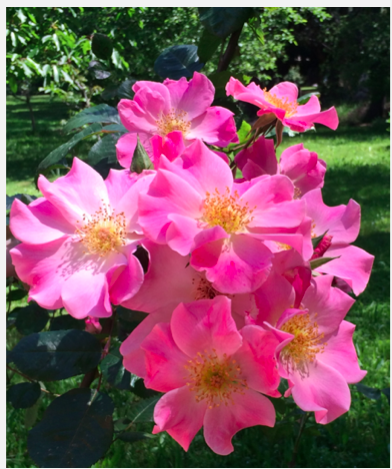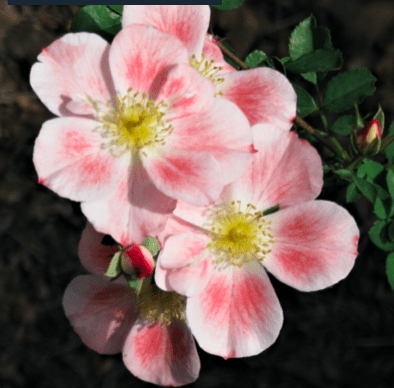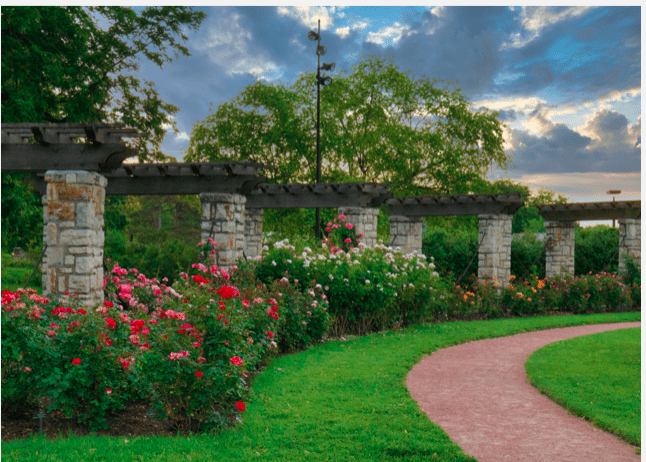American Rose Society’s 2021 Flower Photo Contest
By Jill Brooke

Because people love roses, and it is the National flower as well as the one Aphrodite named for her beloved son Eros, the American Rose Society just completed their annual digital photography contest.
The ARS has been holding this competition for more than 30 years. This year there was more people participating because as ARS’ Beth Smiley observed, “the pandemic must have had everyone taking photos in their gardens.”
Although we regularly feature photographs from the most celebrated artists in the world like Clive Nichols and Deb Shapiro, these are truly amateur photographs and should inspire you to perhaps contribute next year.
It’s easy to do. And it’s always fun to win. Plus it will refocus your lens to start thinking of flowers by looking at their interiors, as well as the petals, and consider the beauty and magic that their existence represents – as well as each flower’s individuality.



Meanwhile, ARS is also sharing the news of a virtual green thumb educational series this Saturday at 1 p.m. called “Landscaping with Roses.” It is hosted by Michael Marriott, one of the world’s leading rosarians, who worked with David Austin for 35 years. Get ready to learn about species roses, old roses, climbers and ramblers and modern roses of course.
He even shows how you can use them as hedges – imagine that. Anyway definitely worth checking out and the pictures are gorgeous.
So what is your favorite rose picture here? There are many options to get involved. Going to share all of them to inspire you. As well as what is involved with the competition. Just do it for fun.

2020 AMERICAN ROSE DIGITAL PHOTOGRAPHY CONTEST **OFFICIAL RULES**
Contestants are permitted to enter a maximum of three digital photographs per class in all classes – excluding Novice, Master, and Youth classes unless otherwise specified.
Contestants may enter only one photo of a variety in ANY class EXCLUDING 13-8
Duplicate photos may NOT be entered in different classes.
Youth who qualify for the Youth class, may submit a total of six photos in the Youth class.
Novice contestants can enter four photos per class in the Novice classes.
“Masters” are defined as any contestant who has won a total of five or more blue ribbons in previous ARS American Rose Digital Photo Contests (excluding Novice, and Youth classes)
Digital photographs must be .jpeg files and must be high resolution files. The high resolution is necessary to ensure that winning entries will print properly in the magazine.
Any photos considered to be low resolution digital files will not be considered for awards.
The entrant must be a current ARS member at the time of the deadline for entries and must have taken all photographs entered.
Photographs which have won any awards (1st – 4th place) in previous ARS American Rose Digital Photo Contests are not eligible. This gives new people a chance for some editorial love.
While the same photo cannot be entered by more than one person, entries from the same garden may be exhibited by multiple members of the immediate family as Exhibitor Grown.
All roses photographed must be outdoor grown roses.
With the exception of seedlings, rose varieties photographed MUST be entered under ARS approved exhibition names (unless otherwise specified) as listed in any of the following official ARS publications: Modern Roses 12 (book and database), the Official List of Approved Exhibition Names for Judges & Exhibitors, the Handbook for Selecting Roses, or “Recent Registrations” on the ARS website. In cases where a variety is not listed in any of the above ARS publications, a listing in the Combined Rose List is acceptable.
Digital photographs shall be saved in the following format: class number with the letters a-c for multiple pictures in the same class, last name of the contestant and the approved exhibition name of the rose. An example would be 10c-Aumiller-Gemini. Only one entry would be 10a-Aumiller-Gemini. Any added text that is on the photo itself will be cause for disqualification.
If the rose(s) being photographed was/were also grown by the exhibitor, the designation “EG” should follow the name of the rose, garden, or arrangement. An example would be 10c-Aumiller-Gemini-EG. This will put the exhibit in the running for medal certificates.
Digital photographs may be enhanced using any graphic program, such as Photoshop, Elements or Photo Impact for the purposes of cropping, rotation, lightening, darkening, minor clean up corrections for camera sensor dirt or sharpening of the image ONLY.
Classes which require or encourage the use of photo editing software for photo enhancement allow any other types of enhancements to be used.
The exhibitor may place nothing identifying the photographer on the front of the photograph. This means no watermarks, copyrights, or imprinted date/time stamps.
Photographs with such identifiers will be disqualified.
The chair of the committee reserves the right to disqualify any entry that does not conform to the stated rules prior to the entries being judged.
Classes
1: One bloom, no sidebuds, of Hybrid Tea, Grandiflora, Miniature, Miniflora, and Floribunda classifications of roses. Roses designated as “single” (eg. Single HT, etc.) must be entered in class 2.
2: One bloom, fully open, no side buds, stamens must show. Roses classified by the ARS as “singles” ARE permitted in this class. Hybrid Tea, Grandiflora, Miniature, Miniflora, and Floribunda classifications of roses are in this class.
3: One spray, two or more blooms, Hybrid Tea, Grandiflora, Miniature, Miniflora, and Floribunda classifications of roses are in this class. This class does NOT include collections.
4: One bloom or spray of an Old Garden Rose, Shrub, Species, Polyantha, or Large Climber. Spray photos do NOT include collections.
5: A photo of a Traditional arrangement, miniature or standard, following the American Rose Society Guidelines for Judging Rose Arrangements. Roses do not need to be identified. The name of the arranger MUST be listed.
6: A photo of a Modern arrangement, miniature or standard, following the American Rose Society Guidelines for Judging Rose Arrangements. Roses do not need to be identified. The name of the arranger MUST be listed.
7: A photo of an arrangement in the Oriental Manner, miniature or standard, following the American Rose Society Guidelines for Judging Rose Arrangements. Roses do not need to be identified. The name of the arranger MUST be listed.
8: Abstract or Impressionism: The photograph should evoke a sense of originality; a new and different way of imagining the rose or roses with the mind’s eye. This may include processes used to alter the original image such as colorizing, black & white, texturizing, dodging, burning, dithering, painting, shadowing, blurring, layering, cloning, filtering, merging, cropping, etc. The name of the rose is NOT required in this class but can be used.
9: Garden: A photo of any rose garden. Photographs should show the use of roses within the structure of a garden, which can be widely variable. Roses should dominate in the photograph, and some layout of the garden should be visible. Roses do not need to be identified. If a public garden is used, the name of the garden MUST be listed.
10: Seedling: A photograph of any seedling which is not currently registered/named. This can be any type of rose. Example of naming the entry would be 10a-Mark Jones Seedling-Aumiller. The name of the hybridizer MUST be listed.
11: Macro Photography: Photographs should be EXTREME closeup photo of any part of the rose or rose plant. This would include prickles, leaves, etc. Color, Black & White, Sepia, or combinations of these are permitted in this class. Roses MUST be identified.
12: Novice Class: Open only to those ARS members who have not previously won an award (first through fourth place) in the ARS American Rose Digital Photo Contest. Eligible contestants may enter either the novice or the regular classes, but not both.
Those entering the novice class may enter any class, 1-11 by preceding the class number with the number 12 (Class 12-1, 12-2, 12-3, etc.). There will be four winners (first place through fourth place), and the first-place winners will be eligible for the Best in Show Award.
13: Master Class: Eligible contestants may have six entries each in the following four classes by preceding the class with the number 13 (Class 13-1, 13-2, 13-3 etc.). There will be six winners (first through sixth place) in each class (13-1 through 13-6) and the first-place winners will be eligible for Best in Show award. Contestants who qualify for this class are ineligible to compete in other classes. Only one photo per variety permitted in each class. Contestants may only have one entry in class 13-8 and there will be only ONE winner in this class (this is Challenge Class).
13-1: One bloom, any classification. No sidebuds are permitted.
13-2: A spray of roses (2 or more blooms) of any classification. This class does NOT
include collections.
13-3: An arrangement, either standard or miniature, following the American Rose
Society Guidelines for Judging Rose Arrangements. Roses do not need to be identified.
The name of the arranger MUST be listed.
13-4: Abstract or Impressionism: The photograph should evoke a sense of originality; a new and different way of imagining the rose or roses with the mind’s eye. This may include processes used to alter the original image such as colorizing, black & white, texturizing, dodging, burning, dithering, painting, shadowing, blurring, layering, cloning, filtering, merging, cropping, etc. The name of the rose is NOT required in this class but can be used.
13-5: A photo of any rose garden. Photographs should show the use of roses within the structure of a garden, which can be widely variable. Roses should dominate in the photograph, and some layout of the garden should be visible. Roses do not need to be identified. If a public garden is photographed, the name of the garden MUST be listed.
13-6: Macro Photography: Photographs should be EXTREME close-up photo of any part of the rose or rose plant. Color, Black & White, Sepia, or combinations of these are permitted in this class.
13-7: Seedling: A photograph of any seedling which is not currently registered/named. This can be any type of rose. Example of naming the entry would be 10a-Mark Jones Seedling-Aumiller. The name of the hybridizer MUST be listed.
13-8: Cycle of Bloom: An entry of three photographs of one variety showing the three stages of development; one bud with petals beginning to unfurl, one at exhibition stage, and one fully open with stamens visible, each stage exhibited in a separate photograph. This class is NOT eligible for the Best in Show award.
14: Youth Class: A photo of one bloom, any classification or a spray of roses (2 or more blooms) of any classification. For all entrants under the age of 16. Exhibitor must list their age on the entry form.
15: Judges Class: This class is open to judges of the ARS Magazine Digital Photo Contest each year. Judges can enter 2 photos that could be entered in the regular show (classes 1-11). This class is NOT eligible for the Best in Show award.
Okay everyone. This gives you a sample of what most competitions require and as you can see, anyone can contribute.
